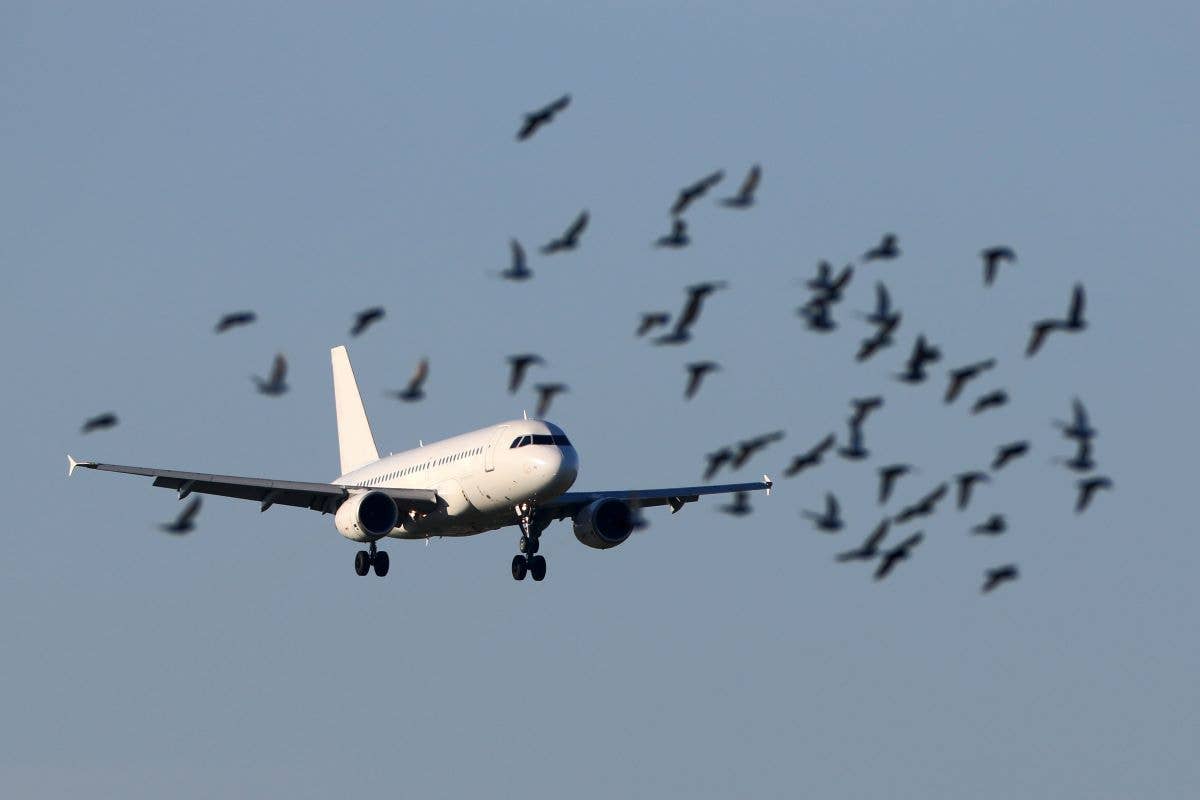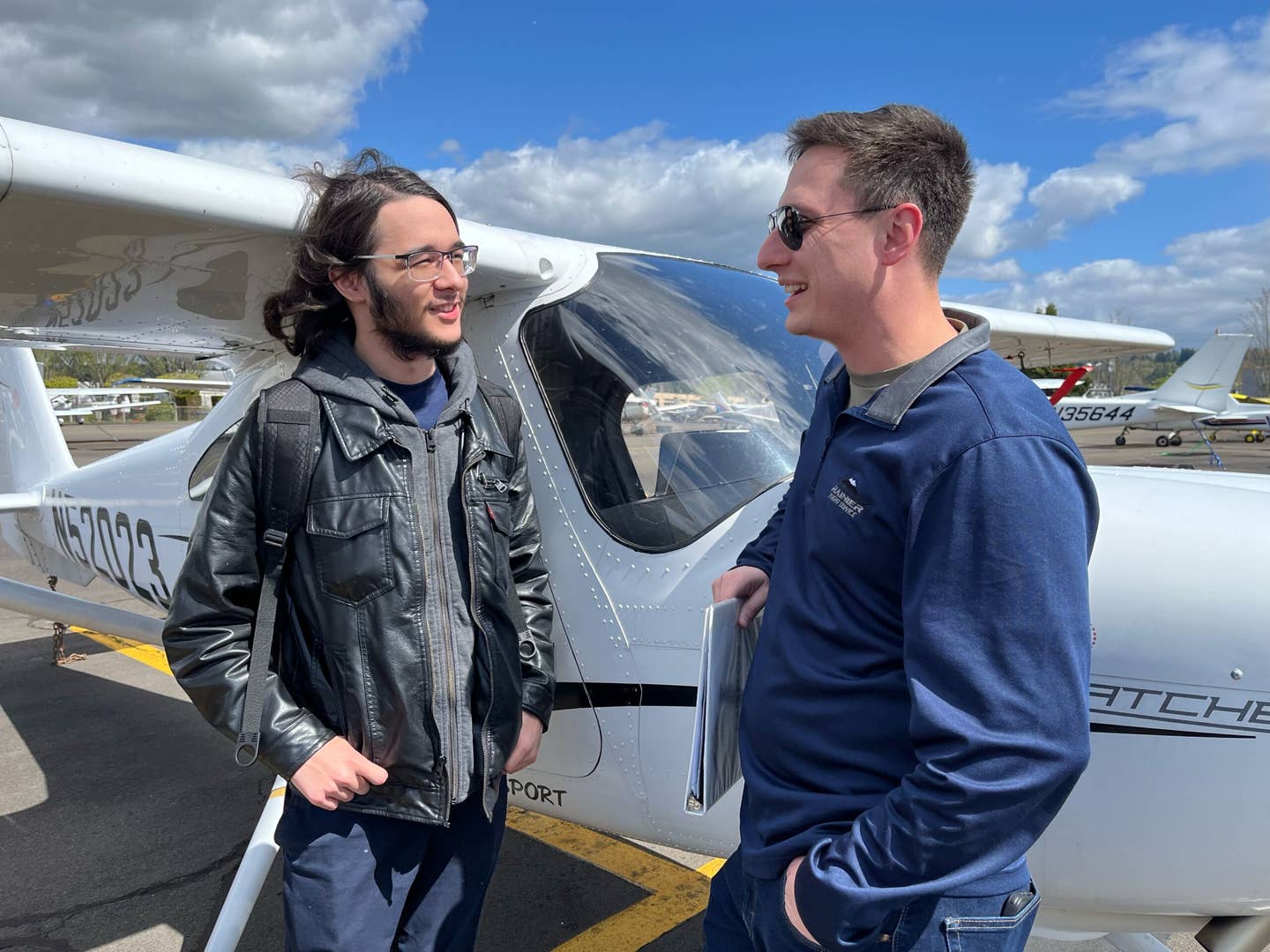Avoiding and Surviving Bird Strikes
According to the FAA, pilots are asked to report encounters with all birds, bats, and terrestrial mammals larger than 2.2 pounds.

When it comes to bird strikes, authorities want to know what kind of animal was hit and where the collision took place, including the altitude. [Credit: Shutterstock]
“What the —!” the learner cried out as we rolled out from landing.
Ahead of us some 1,000 feet down the runway there was a bald eagle standing on the centerline, scarfing down the carcass of what looked like a large white rabbit. We brought the aircraft to a stop as the bird stopped its feeding frenzy and hopped toward us, spreading its wings and obviously saying, “Come at me, bro!” in eagle.
We had three choices: We could try to scare the bird away by heading toward it and run over the carcass in the process, go off the runway to the side and take our chances in the grass area that needed mowing, or we could do a 180-degree turn and taxi back. I chose door number three and in taking the aircraft demonstrated the pivot turn to the learner.
As he taxied us back to the ramp, I got on the unicom and reported that there was an eagle parked on the runway. That brought out the airport manager with his truck and big shovel. He scared off the bird by waving the tool, then picked up the remains of the white rabbit and flung it into the woods on the east side of the airport. The eagle flew after the carcass. Within 10 minutes there was a warning on the one-minute weather about wildlife in the vicinity of the airport.
The airport manager later told me that as it was May and the carcass was that of a white domesticated rabbit and figured it was a pet Easter bunny that had been dumped. Sadly, this happens a lot and pretty much condemns the animal to death. He also noted that there is no such thing as one rabbit, suggesting the abandoned pet was pregnant when it was left and likely mixed with the wild population, resulting in more rabbits. Their presence attracts the higher predators such as coyotes and eagles—two animals you definitely don’t want to hit with an aircraft. He was right. In the following weeks, there was an uptick in coyote and eagle encounters at the airport.
One of the most frequently asked questions is how much trouble would a pilot be in if they accidentally hit a bald eagle—or any animal for that matter. The answer is none. However, the FAA has provided us with guidance with Advisory Circular (AC) 150/5200-32B.
According to the AC, pilots are asked to report encounters with all birds, bats, and terrestrial mammals larger than 2.2 pounds. That means if you hit a rabbit, muskrat, armadillo, fox, coyote, domestic animal, deer or something else with hooves, the FAA wants to know about it because it helps the agency create wildlife management plans to make airports safer.
Additionally, biologists want to know about these things because it can help them track migratory patterns.
An increase in animal activity at an airport can also be a clue that there is something else happening on the property.
For example, when deer and elk started appearing en masse on the north end of the airport, the manager realized there was likely a hole in the fence against the tree line. There were thick trees on both sides of the fence, so getting to it involved making your way through a lot of slash and uneven terrain. But someone did it and had cut the chain-link fence intentionally.
Based on the tire tracks that appeared to be from ATVs—and the number of hangars that were broken into—it was suggested that someone was accessing the airport to steal tools and anything else they could sell for scrap metal.
If You Hit an Animal
The AC has instructions on how to file a report and with whom. Pilots are asked to do this when “bird or other wildlife remains, whether in whole or in part, are found: (1) Within 250 feet of a runway centerline or within 1,000 feet of a runway end unless another reason for the animal's death is identified or suspected.”
In addition, the FAA wants to know about it if “the presence of birds or other wildlife on or off the airport had a significant negative effect on a flight," such as forcing the pilot to abort takeoff or the aircraft leaving the pavement to avoid a collision.
You can report the event online at the Airport Wildlife Hazard Mitigation website or via mobile devices.
The Worst Thing to Hit
According to the AC, the animal encounters that are likely to result in the most damage are white-tailed deer, snow goose, turkey vultures and Canada geese.
I have encountered all of these, fortunately from a distance. Mostly we have geese in the Pacific Northwest, and airports invest a lot of time and money into methods to deter the birds from roosting there. This includes noise cannons, using an airport dog to chase them away, or having someone drive around in a golf cart to chase them away.
There are some airports that disguise ponds on their property by filling them with black or gray plastic balls (think the ball pit at a kid’s amusement center). From the air the birds see the black and gray and assume that it is cement, not water, so they do not land.
If you see a gaggle of geese near the runway, notify airport personnel before you take off or land. The staff will likely chase them off before you take the runway. Bonus note: If you land at an airport and see plywood dogs mounted on revolving poles in the airport grass infield, that’s a good indication they have bird issues. Birds see the faux dogs moving in the wind and avoid the area.
Avoiding Birds
You can decrease your chances of having a bird strike by avoiding places they congregate, such as bird sanctuaries. Pay attention to the altitude restrictions noted on the VFR sectional and terminal charts, especially along coastlines.
Most birds fly at 2,500 feet or less, so flying higher than that can mitigate your risk. Be careful with flocks of starlings and seagulls as their numbers can create serious issues if you fly through them. If you see them on the ground, don’t buzz them. They will likely launch in a panic with disastrous results.
Unfortunately, most of our knowledge about bird strike avoidance is theoretical and anecdotal. Some pilots believe that turning on the landing light will deter birds because they will see and avoid the aircraft.
If you see a bird approaching head-on, pull up, being careful not to stall the aircraft. The birds often dive to avoid aircraft—so do bats. But sometimes you just don’t have the time to react. I speak from experience.
I was flying with a learner on downwind at an altitude of 1,000 feet agl when we saw a red-tailed hawk heading right for us. It had descended into the pattern, and it was going the opposite direction. It had its belly toward us, and it was flapping wildly. There was a thump, followed by a shudder in the airframe, and we felt and heard something roll over the top of the aircraft. I took the controls and gingerly tested the rudder and elevator while my learner looked outside for damage. We didn’t see any, and the landing was normal. After landing we discovered a small dent, and some blood and feathers stuck to the top wing next to the air vent.
We had noted where the strike took place, including the altitude and our airspeed at the time of impact. This information was used to fill out the FAA Bird/Wildlife Strike Report.
We were lucky because we were not going too fast, and the bird did not hit the windscreen. The higher the speed, the greater risk of structural damage. GA aircraft windscreens are definitely not designed to withstand bird strikes.
The most important thing to remember if you encounter a bird strike is to fly the airplane. Pilots who have experienced bird strikes that resulted in significant damage tell stories of the aircraft "flying a little wonky" because of a big dent in the wing or tail and having trouble maintaining altitude if the windscreen is compromised.
But they lived to tell the story. That’s what’s important.

Sign-up for newsletters & special offers!
Get the latest FLYING stories & special offers delivered directly to your inbox






